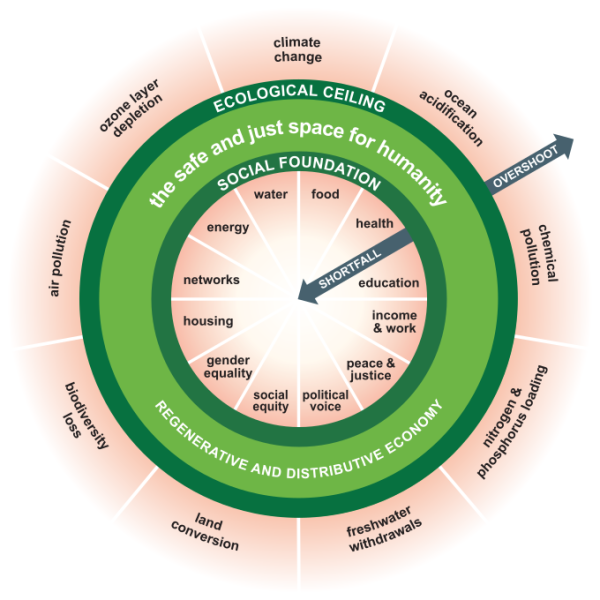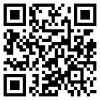Doughnut economy
| [checked revision] | [checked revision] |
Caesajanth (talk | contribs) No edit summary |
Caesajanth (talk | contribs) No edit summary |
||
| (8 intermediate revisions by the same user not shown) | |||
| Line 9: | Line 9: | ||
In this context successful economic activity is understood as balancing protection of the key ecological systems of the planet with achieving social wellbeing and quality of life for everybody. Here, economy is not a separate dimension. Rather, it is a factor that can generate future viability as an integrative aspect of sustainability. | In this context successful economic activity is understood as balancing protection of the key ecological systems of the planet with achieving social wellbeing and quality of life for everybody. Here, economy is not a separate dimension. Rather, it is a factor that can generate future viability as an integrative aspect of sustainability. | ||
<loop_figure title="The doughnut of social and planetary boundaries" | |||
description="Credit to: Kate Raworth and Christian Guthier. CC-BY-SA 4.0" id="6898a1ecebb3f"> | |||
[[File:C8.3.2 img.png|center|600px]] | |||
</loop_figure> | |||
Following Kate Raworth<ref><small>Cf. Raworth (2017) <cite id="">Ra17</cite></small></ref>, who first introduced the model, sustainability can be achieved by a change of consumption and production patterns. Raworth suggests that the model provides a chance to rethink economic development. Instead of putting economic growth first, it is about ensuring human rights and living within the limits of planet earth. The question then is: Which kind of economic system would make it possible to achieve these goals? | |||
<loop_area type="websource"> | |||
[[File:c8.3.2_web.png|right|100px]] '''Further reading:'''<br>Raworth, Kate (2020).<br>[https://doughnuteconomics.org/about-doughnut-economics About Doughnut Economy].<br>Doughnut Economics Action Lab. | |||
</loop_area> | |||
<loop_noprint button="false"><loop_area icon="IconVideo.svg" icontext="Video"><loop_media type="video" title="What is Doughnut Economics? with Kate Raworth" description="" copyright="" show_copyright="true" index="true" id="">{{#ev:youtube|kxQeb2PDz9M}}</loop_media>[[File:c8.3.2_vid.png|right|100px]] YouTube – Ross Harrison<br><br><br><small>Time to watch 1m35s</loop_area></loop_noprint> | |||
< | <loop_print button="false"> | ||
[[File:c8.3. | <loop_area icon="IconVideo.svg" icontext="Video">[[File:What is Doughnut Economics - with Kate Raworth.jpg|center]] | ||
</ | [https://www.youtube.com/watch?v=kxQeb2PDz9M Med. 8.3: What is Doughnut Economics? with Kate Raworth]<br>[[File:c8.3.2_vid.png|right|100px]] YouTube – Ross Harrison<br><br><br><small>Time to watch 1m35s</small></loop_area></loop_print> | ||
<loop_area type="practice" icontext="Tool"> | |||
'''Interactive open access tools''' | |||
[https://doughnuteconomics.org/tools Doughnut economics action lab tools] which allow exploring how different stakeholders can get engaged in pursuing actions suggested by the doughnut economy. | |||
</loop_area> | |||
Latest revision as of 14:45, 24 August 2025
The doughnut economy is an economic model that is embedded in society and the environment. The outer crust of the doughnut represents the planetary boundaries or the environmental ceiling which must be protected in order to guarantee a good life for current and future generations. Hence, e.g. climate change, land conversion and the loss of biodiversity (vide: arrow overshoot) must be halted.
The hole in the centre of the doughnut represents the space for people who do not have access to the essential social foundations of life such as education, health care, social equity, housing (vide: arrow shortfall).
The spot in between the outer and inner circle represents the space where everybody is enabled to live a good life below the planetary boundaries.[1]
The area beyond ‘the safe and just space of humanity’ represents the section where people transcend the boundaries of the planet.
In this context successful economic activity is understood as balancing protection of the key ecological systems of the planet with achieving social wellbeing and quality of life for everybody. Here, economy is not a separate dimension. Rather, it is a factor that can generate future viability as an integrative aspect of sustainability.

Following Kate Raworth[2], who first introduced the model, sustainability can be achieved by a change of consumption and production patterns. Raworth suggests that the model provides a chance to rethink economic development. Instead of putting economic growth first, it is about ensuring human rights and living within the limits of planet earth. The question then is: Which kind of economic system would make it possible to achieve these goals?

Further reading:
Raworth, Kate (2020).
About Doughnut Economy.
Doughnut Economics Action Lab.
Interactive open access tools
Doughnut economics action lab tools which allow exploring how different stakeholders can get engaged in pursuing actions suggested by the doughnut economy.
Bernd G. Lottermoser /
Matthias Schmidt (Ed.)
with contributions of
Anna S. Hüncke, Nina Küpper and Sören E. Schuster
Publisher: UVG-Verlag
Year of first publication: 2024 (Work In Progress)
ISBN: 978-3-948709-26-6
Licence: Ethics in Mining Copyright © 2024 by Bernd G. Lottermoser/Matthias Schmidt is licensed under Attribution-ShareAlike 4.0 International Deed, except where otherwise noted.


Further Informationen:
Project "Ethics in Mining"
